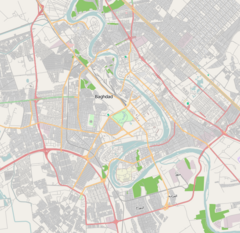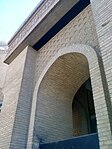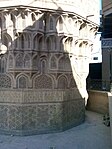Al-Khulafa Mosque
| Al-Khulafa Mosque Al-Qasr Mosque | |
|---|---|
 | |
| Religion | |
| Affiliation | Islam |
| Rite | Sunni Islam |
| Ecclesiastical or organisational status | Mosque |
| Status | Active |
| Location | |
| Location | Baghdad, Iraq |
| Geographic coordinates | 33°20′20″N 44°23′52″E / 33.3388633°N 44.3977341°E |
| Architecture | |
| Type | Mosque |
| Style | Abbasid architecture |
| Founder | Al-Muktafi |
| Groundbreaking | 902 |
| Completed | 908 |
| Specifications | |
| Minaret(s) | 1 |
| Minaret height | 34 metres (112 ft) |
Al-Khulafa Mosque (Arabic: جامع الخلفاء, romanized: Jami' Al-Khulafa) is a historic Sunni Islamic mosque located in Baghdad, Iraq. It is located on the Jumhuriya Street in al-Rusafa side of the city. It is the oldest surviving mosque in Baghdad.[1] The mosque, along with its minaret, was completely rebuilt and restored in the 1960s by the Ministry of Awqaf in its current shape to this day.[2]
The minaret dates back to the time of the Abbasid Caliphate and has been standing for 1,200 years and used to be the highest point in Baghdad. Due to this, the mosque is referred to as one of the most important Islamic and historic landmarks in the city. However, in recent years the mosque has been threatened with collapse due to neglect from the Iraqi government.[3] The mosque is also located across the street from the Latin Cathedral of St. Joseph in the Shorja area.[4]
Historical background
[edit]Abbasid foundation (902-1258)
[edit]
The mosque dates back to the Abbasid era and was commissioned by the 17th Abbasid Caliph, al-Muktafi (r. 902–908), as a Friday mosque for the sprawling palace complex erected by him and his father, Caliph al-Mu'tadid. Due to this, the mosque was often also called al-Qasr Mosque (Arabic: جامع القصر) which means the "mosque of the palace" in Arabic. Later the mosque was dubbed the Mosque of Caliph, which gave the current name Jami' al-Khulafa.[5][6]
With construction starting in 902 the same year al-Muktafi became Caliph and was built on the grounds of Qasr al-Khulafa which also contained a prison and vaults which housed workmen who worked on the Qasr al-Hasani. Originally, the mosque was supposed to be used for personal use for the Caliph but was then opened to the public and remained open for the last four centuries of the Abbasid Caliphate's existence.[7] Abbasid Caliphs would also take to the mosque and use it as their central place of worship until the 13th century.[8] Residents would favor coming to the mosque and remained until close to night time to discuss various private affairs.[7] The mosque was the second of the three great mosques of East Baghdad at the time of the Abbasids, the other two being al-Rusafa Mosque (which contained the tombs of Abbasid Tombs), and the Seljuk Mosque of the Sultan.[7][9]
The most notable part of the mosque is its 34-metre (112 ft) Abbasid minaret which is still surviving in its original form dating back to that period. The minaret is the only part remaining from the original construction. It is set on the southeast corner of the sahn and constructed in brick and mortar. The minaret and its foundation are decorated with muqarnas, and the frame of the minaret is engraved with Kufic inscriptions and Islamic geometric patterns.[2]
Post-Abbasid Caliphate (1258-1932)
[edit]As a result of its significant age, the mosque is one of the historic landmarks of the city of Baghdad. Al-Khulafa Mosque was also notably mentioned in the Ibn Battuta’s travel record when he visited Baghdad in 1327. The mosque has also suffered through many wars to the point that only the original minaret remained of it throughout its existence.[5][6] The minaret was also reportedly refurbished during the Ilkhanate period.[10]
Around 1779 and 1780, Suleiman the Great the ruler of the Mamluk state of Iraq renewed parts of the mosque and established a scientific madrasa that taught mental sciences with many scholars studying at the madrasa throughout its existence.[11] During James Silk Buckingham's visit to Baghdad in 1816, al-Khulafa Mosque was one of the mosques he visited which was located in Souk al-Ghazil and noted how the remains of the mosque and the minaret looked like they were affected by "marks of violence." Due to the location of the mosque, Buckingham called it the "Souk al-Ghazil Mosque.[12] He noted in his travels:
The body of the original building appears to have been destroyed by violence. No more remains of it at present than the minaret and a small portion of the outer walls. The former of these is a short, thick, heavy column, of the most graceless proportions, built of bricks, diagonally crossed, and varied on colours, as in the minaret of the Great Mosque at Mousul.[12]
Restoration and later events (1960-Present)
[edit]
The minaret was refurbished in 1960 and a project by the Ministry of Awqaf was carried out to rebuild the mosque and hire architect Mohamed Makiya for the major project. The project was completed in 1964 in the mosque's current form with Mohamed drafting proposals to rehabilitate the mosque in 1981.[2] Makiya was a Baghdadi architect who was concerned in architectural heritage, and the many traditional ways they're built which would lead him to work on the project. While the modern project's site was smaller than that referred to in historical records,[13] and was completed on a lower budget,[14] Makiya managed to develop an accurate design for the mosque and its architecture which was extracted from various periods of Islamic architecture. Makiya has also decided to keep using traditional Iraqi bricks as the main building resource for the mosque to reflect the local identity. Makiya's mosque restoration later impacted his work as he would design future buildings that reflected traditional culture without neglecting modern architectural features.[13] The project was Makiya's first important work.[14]
Recognized as Baghdad's oldest surviving mosque, the mosque was notably visited by British ethnomusicologist Jean Jenkins in 1970 who recorded a three-minute track of a Qu'ran reading session during Friday prayers at the mosque which would later be aired on BBC radio 4 as an ending to a program from that period which aired Sufi music from Kabul, also recorded by Jenkins. The recordings intended to show an example of Islamic harmony.[15]
Eventually, in the early 1980s, there was a plan drafted to expand the mosque Makiya after former Iraqi president Saddam Hussein declared the mosque a masterpiece reminiscent of Iraq's Abbasid past. Hussein had notably expressed great interest in religious and mosque designs during this period. The plan would've seen the demolishment of many of its surroundings but the plan was never put into development.[16]
Among the scholars who held the position of imam and rhetoric in the mosque was Sheikh Jalal al-Din al-Hanafi, who was the imam of the mosque for several decades and helped in the maintenance and preservation of the mosque such as the fence which is decorated by Islamic calligraphy.[17] Al-Hanafi was also bold in his position as he prevented the installation of loudspeakers in the mosque and instead preferred to do the call of prayer on the pulpit. This decision was because loudspeakers "annoy non-Muslims, children, the sick, and the elderly, and there is no need for them. People watch and know prayer times from the radio and television." Al-Hanafi was known to have a great love for al-Khulafa Mosque due to its age and architecture; to this day, the mosque is sometimes associated with al-Hanafi since he spent much time in the mosque.[18] It should also be noted that al-Hanafi was the last scholar to ever study at the mosque.[11]

However, today there is a concern of its collapsing due to the lack of maintenance allegedly stemming from the sectarian segregation between the Sunni-oriented mosque and the Shi'i-majority government.[19] Because of the minaret's tilt, the mosque is better known by locals as "al-Ahdab" (Arabic: الأحدب), meaning "the hunchback".[20] Despite its important historical background, the mosque has also lost its relevancy among the Baghdadi public eye throughout the years in favor of Souk al-Ghazali.[21]
A spokesman for the Ministry of Culture, Ahmed al-Olayawi, commented on the delay in restoring the mosque by saying that the rehabilitation of the mosque and its minaret is not easy, because this site extends for hundreds of years and is considered a historical landmark of Baghdad, and therefore it needs deep studies before starting. A British committee of experts is currently studying the mosque to rehabilitate the mosque.[3] The Sunni Endowment Office has also concluded an agreement with UNESCO in 2017 in order to preserve the mosque.[22]
As of 2024, the mosque remains in a dire state of neglect with a dilapidated sign on its gate reading “The mosque is closed for maintenance purposes”. Due to the loss of many historic landmarks around Baghdad in recent years, the mosque is considered endangered, and Independent Arabia reported the Sunni Endowment Office had no information about the mosque and its many issues. The paper also noted the lack of knowledge of the mosque's history and significance among the locals during an opinion survey.[23]
Architecture
[edit]Current layout and structure
[edit]When restoring the mosque, architect Mohamed Makiya wanted the mosque's design to be as accurate to Islamic architecture during the Abbasid period as possible, as such the intention was to make the mosque as if it had never been demolished previously. Three gates lead to the chapel of the mosque which is octagonal and topped with a 14-meter dome decorated with Kufic script. The mosque was colored in the same yellowish colors to match the color of the minaret and the mosque is decorated in many Islamic and geometric shapes.[24]
The exterior walls of the main haram are covered in bricks with varying shades of yellow arranged in geometric patterns with the interior walls being covered by precast concrete. Arches of the mosque are also topped by geometric patterns. The mosque is topped by a large dome covered in the same yellow geometric brickwork that covers the entire mosque's façade and matches with the minaret. The interior of the dome is covered in various arabesque patterns.[25]
- Gallery of the Mosque's features
-
The prayer space of the mosque.
-
Interior detail of the Khulafa Mosque's big dome.
-
Islamic decoration on the mosque's stones and bricks.
-
The exterior of the mosque's building.
-
A window.
Minaret
[edit]The most significant part of the mosque is its minaret which dates back to the Abbasid period and is the most preserved part of the mosque. It is about 35 meters high with a cylindrical shape that includes four layers of muqarnas supporting the base of the minaret.[24] The minaret is similar in terms of design to the minaret of Bastam in Iran, which was built in 1120, and is similar to the minaret of al-Nukhailah Mosque.[1]
- Gallery of the Abbasid Minaret
-
The Abbasid minaret as seen from ground level.
-
Ground level view of the first bands of the muqarnas and the decorations of the minaret.
-
The four bands of muqarnas below the minaret.
-
Closeup of the muqarnas and their decorations which date back to the Abbasid era.
See also
[edit]- Abbasid Palace – Another preserved Abbasid landmark
- Abu Hanifa Mosque – Preserved Abbasid mosque
- Haydar-Khana Mosque – Preserved Abbasid mosque
- Islam in Iraq
- Mustansiriya Madrasa – Another preserved Abbasid landmark
- List of mosques in Iraq
- List of mosques in Baghdad
References
[edit]- ^ a b The Book of Mosques of Baghdad - written by Dr. Younis Al-Samarrai - Chapter One, Old Rusafa Mosques: The Mosque of the Caliphs - Page 22.
- ^ a b c Khulafa Central Mosque. Archnet. Retrieved January 5, 2018.
- ^ a b الصالحي, رامي. "منارة جامع الخلفاء في بغداد مهددة بالانهيار.. والسلطات لا تعير اهتماما رغم مكانته التاريخية". www.aljazeera.net (in Arabic). Retrieved 2023-08-15.
- ^ Alsayer, Dalal Musaed; Camacho, Ricardo; Soares, Sara Saragoça (2022-01-19). Pan-Arab Modernism 1968-2018: The History of Architectural Practice in The Middle East. Actar D, Inc. p. 321. ISBN 978-1-63840-825-3.
- ^ a b كتاب دليل خارطة بغداد المفصل - تأليف الدكتور مصطفى جواد والدكتور أحمد سوسة - مطبعة المجمع العلمي العراقي. 1958. p.125.
- ^ a b "أمانة مجلس الوزراء تتحرك لانقاذ مئذنة أثرية من السقوط". شفق نيوز. Retrieved 2023-08-15.
- ^ a b c Strange, g le (1922). Baghdad During The Abbasid Caliphate,ed.2.
- ^ Baghdād: From Its Beginnings to the 14th Century. BRILL. 2022-07-25. ISBN 978-90-04-51337-2.
- ^ Marozzi, Justin (2014-05-29). Baghdad: City of Peace, City of Blood. Penguin UK. ISBN 978-0-14-194804-1.
- ^ Baghdād: From Its Beginnings to the 14th Century. BRILL. 2022-07-25. p. 8. ISBN 978-90-04-51337-2.
- ^ a b الكيلاني ،السيد, ميعاد شرف الدين (2015-01-01). مدارس بغداد القديمة 941 - 1336 هـ / 1534 -1917 م (in Arabic). Dar Al Kotob Al Ilmiyah دار الكتب العلمية. ISBN 978-2-7451-8403-0.
- ^ a b Buckingham, James Silk (1827). Travels in Mesopotamia. H. Colburn. pp. 181–182.
- ^ a b Elsheshtawy, Yasser (2004-08-02). Planning Middle Eastern Cities: An Urban Kaleidoscope. Routledge. pp. 74–75. ISBN 978-1-134-41010-1.
- ^ a b Bloom, Jonathan; Blair, Sheila (2009-05-14). Grove Encyclopedia of Islamic Art & Architecture: Three-Volume Set. OUP USA. p. 435. ISBN 978-0-19-530991-1.
- ^ Franklin, Marianne (2021). Sampling Politics: Music and the Geocultural. Oxford University Press. p. 285. ISBN 978-0-19-085547-5.
- ^ Makiya, Kanan (2003-12-31). The Monument: Art and Vulgarity in Saddam Hussein's Iraq. Bloomsbury Publishing. pp. 95–99. ISBN 978-0-85771-488-6.
- ^ دليل الجوامع والمساجد التراثية والأثرية - ديوان الوقف السني في العراق - صفحة 18، 19.
- ^ "الگاردينيا - مجلة ثقافية عامة - جلال الدين الحنفي شيخ بغداد وعاشقها". www.algardenia.com. Retrieved 2023-09-15.
- ^ Why is Khulafa Mosque's minaret on verge of collapse? Al Monitor. Retrieved January 5, 2018.
- ^ "The Taj Mahal And The Golden Age Of Islam". Ancient Engineering. Season 1. Episode 10. 2021. Event occurs at 21:49. CuriosityStream.
- ^ والي, نجم; الساقي, دار (2017-03-17). بغداد سيرة مدينة: سيرة مدينة (in Arabic). Dar al Saqi. ISBN 978-614-03-0007-1.
- ^ "مدير عام الدائرة الهندسية يتفقد مأذنة جامع الخلفاء - ديوان الوقف السني". 2020-01-10. Archived from the original on 2020-01-10. Retrieved 2023-08-16.
- ^ "جامع الخلفاء في بغداد صرح عباسي في طي النسيان". اندبندنت عربية (in Arabic). 2024-04-24. Retrieved 2024-04-27.
- ^ a b "جامع الخلفاء في بغداد تحفة معمارية لمحمد مكية - المشاهير". 2020-01-10. Archived from the original on 2020-01-10. Retrieved 2023-08-16.
- ^ Trevathan, Idries (2024-03-29). Mosque: Approaches to Art and Architecture. Taylor & Francis. ISBN 978-1-003-85436-4.










